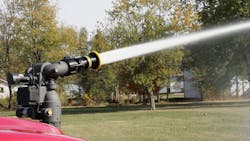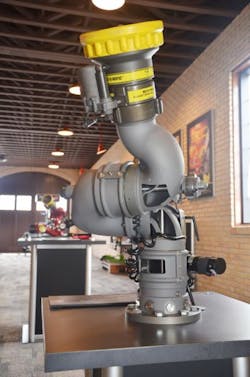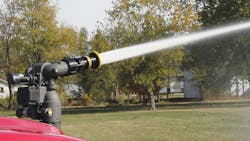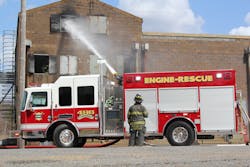Absolute encoders let water cannon douse flames accurately
Remotely controlled water cannons stay focused on their target thanks to their use of absolute position sensors on their X and Y axes.
The encoders are Vert-X 1300 noncontact rotary position sensors from Novotechnik, Southborough, Mass. The sensors use the Hall effect to note rotary position. They go on Sidewinder EXM water cannons from Elkhart Brass Mfg. Co., Elkhart, Ind.
One sensor goes on a thrust rod that takes axial hydraulic pressure off the ball bearings on the joint that permits Y-axis rotation of the water stream. The other sensor is on the thrust rod performing a similarShock and vibration ratings of 50 g and 20 g, respectively, and Ingress Protection Ratings of 67 let the sensors handle the pressure levels routinely seen in water cannons.
Rotational limits and block-out zones for the cannons are controlled via position information from the encoders. Absolute encoding lets the cannons be accurately positioned even in the event of power loss. Moreover, firefighters or other users may move the cannons manually, so the positioning system must track where the device is aimed to prevent a high-pressure water stream from being inadvertently directed at bystanders.
In typical uses, water pressure in these systems can go from zero to as high as 1,500 psi, and water flow is 15 to 3,000 gpm. The time it takes for pressure to build from zero to a maximum level can be as short as a few seconds.
Users control the cannon from the safety of a fire truck using a joystick.
The EXM has a travel range of ±175° horizontally and 145 to 175° vertically. The devices can also mount on stands, fire hydrants, and elsewhere. Rotational limits can be set to avoid directing high velocity water where it isn’t wanted, such as outside a cone of operation for a particular fire.
The Sidewinder EXM has a plug-and-play digital communication and control architecture that operates on the CANbus protocol. The bus also lets operators control the engine, pump, valves, and lights, as well as cameras and aerial ladder on the fire truck, via a central controller. Besides the joystick, firefighters view an LED display of the spray-nozzle position.
About the Author
Leland Teschler
Lee Teschler served as Editor-in-Chief of Machine Design until 2014. He holds a B.S. Engineering from the University of Michigan; a B.S. Electrical Engineering from the University of Michigan; and an MBA from Cleveland State University. Prior to joining Penton, Lee worked as a Communications design engineer for the U.S. Government.




